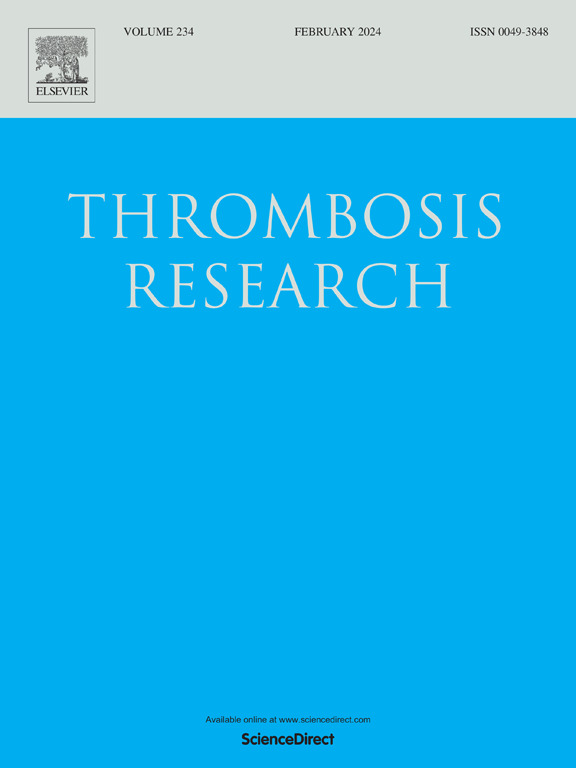Protein disulfide isomerase 1 (PDIA1) regulates platelet-derived extracellular vesicle release
IF 3.7
3区 医学
Q1 HEMATOLOGY
引用次数: 0
Abstract
Background
Protein disulfide isomerase 1 (PDIA1) and 3 (PDIA3) regulate platelet activation and thrombus formation. However, their role in the formation of platelet-derived extracellular vesicles (pEVs) remains unknown.
Aim
To characterise the effects of PDIA1 and PDIA3 inhibition on pEV formation in washed murine platelets in response to platelet glycoprotein VI (GPVI) receptor or intracellular calcium signal activation.
Methods
Washed platelets were isolated from C57BL/6 mice and activated using convulxin or the calcium ionophore A23187. Then, the resulting pEVs were analysed using nano flow cytometry (FC), platelet aggregation was measured by FC and a 96-well plate-based assay, and intracellular free calcium concentration ([Ca2+]i) was measured by indicator fluorescence. Platelet PDIs were blocked by a classic selective PDIA1 inhibitor (bepristat 2a) and sulphonamides of aziridine-2-carboxylic acid derivatives, novel PDI inhibitors relatively selective for PDIA1 or PDIA3 (C-3389 and C-3399, respectively). Clinically relevant antiplatelet drugs were used for comparison.
Results
Convulxin and A23187 concentration-dependently induced pEV formation. However, unlike convulxin, platelet activation by A23187 did not stimulate their aggregation. Bepristat 2a, C-3389 and C-3399 inhibited convulxin-induced pEV release accompanied by the reduction of [Ca2+]i. In contrast, only bepristat 2a inhibited A23187-induced pEV release, but without effect on [Ca2+]i. Cangrelor and tirofiban, but not acetylsalicylic acid (ASA), inhibited convulxin-induced pEV release, but neither of them inhibited A23187-induced pEV release.
Conclusion
The inhibition of PDIA1 represents a novel approach to inhibit pEV formation by a mechanism independent of platelet aggregation and calcium signaling.
蛋白二硫异构酶 1 (PDIA1) 调节血小板源性细胞外囊泡的释放。
背景:蛋白二硫异构酶1(PDIA1)和3(PDIA3)可调节血小板活化和血栓形成。目的:描述在血小板糖蛋白VI(GPVI)受体或细胞内钙信号激活的情况下,抑制PDIA1和PDIA3对洗涤小鼠血小板中pEV形成的影响:方法:从 C57BL/6 小鼠体内分离出洗涤血小板,并使用卷曲霉素或钙离子诱导剂 A23187 激活血小板。然后,用纳米流式细胞术(FC)分析所产生的 pEV,用 FC 和 96 孔板检测法测量血小板聚集,用指示荧光测量细胞内游离钙浓度([Ca2+]i)。经典的选择性 PDIA1 抑制剂(贝普利司他 2a)和对 PDIA1 或 PDIA3 有相对选择性的新型 PDI 抑制剂(分别为 C-3389 和 C-3399)氮丙啶-2-羧酸衍生物磺酰胺类药物可阻断血小板 PDI。临床相关的抗血小板药物被用来进行比较:结果:Convulxin 和 A23187 浓度依赖性地诱导 pEV 的形成。然而,与卷曲霉素不同的是,A23187 对血小板的激活并不刺激其聚集。Bepristat 2a、C-3389 和 C-3399 可抑制卷曲霉素诱导的 pEV 释放,同时降低[Ca2+]i。相反,只有贝普利司他 2a 能抑制 A23187 诱导的 pEV 释放,但对[Ca2+]i 没有影响。坎格雷洛和替罗非班(而非乙酰水杨酸(ASA))抑制了卷曲霉素诱导的 pEV 释放,但它们都没有抑制 A23187 诱导的 pEV 释放:结论:抑制 PDIA1 是通过独立于血小板聚集和钙信号转导的机制抑制 pEV 形成的一种新方法。
本文章由计算机程序翻译,如有差异,请以英文原文为准。
求助全文
约1分钟内获得全文
求助全文
来源期刊

Thrombosis research
医学-外周血管病
CiteScore
14.60
自引率
4.00%
发文量
364
审稿时长
31 days
期刊介绍:
Thrombosis Research is an international journal dedicated to the swift dissemination of new information on thrombosis, hemostasis, and vascular biology, aimed at advancing both science and clinical care. The journal publishes peer-reviewed original research, reviews, editorials, opinions, and critiques, covering both basic and clinical studies. Priority is given to research that promises novel approaches in the diagnosis, therapy, prognosis, and prevention of thrombotic and hemorrhagic diseases.
 求助内容:
求助内容: 应助结果提醒方式:
应助结果提醒方式:


